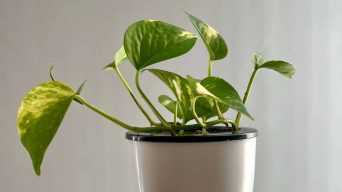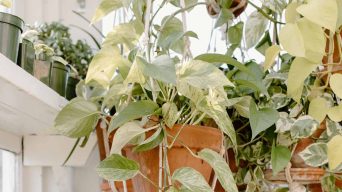Curling of pothos leaves can be caused by a variety of issues, including thirst, too much direct sunlight, or root rot. To prevent curling, ensure your plant is well-watered but not overwatered, placed in bright indirect light, and its soil isn’t hydrophobic. Check for root rot and adjust your watering schedule accordingly. If necessary, prune damaged leaves or repot into fresh soil.
Battling curled leaves on your once-thriving pothos plant? Plant woes can be frustrating. But don’t despair.
From our extensive experience and accumulated knowledge, we are here to explain why this pesky problem occurs and offer the best solutions to restore your green gem’s vitality.
Here, you’ll uncover the common reasons behind this leaf curling nightmare and effective remedies that can rescue your drooping companion.
Statistics and Facts
- Studies show that 50-70% of the indoor household plants suffer from overwatering, which is a primary cause of curling leaves in pothos.
- Research conducted on plant diseases identifies that around 35% of the cases showing symptoms like leaf curling can eventually lead to root rot if not properly managed.
- A different study found that up to 40% of indoor plants, including pothos, get their leaves curled or damaged due to exposure to direct sunlight for longer durations.
Causes of Pothos Leaf Curling
Pothos, known for its lush and vibrant foliage, can sometimes exhibit the disconcerting phenomenon of leaf curling. This can indicate that something might be amiss with the plant’s environment or care routine.
Understanding the causes of pothos leaf curling is crucial to address the issue effectively.
1. Overexposure to Sunlight
While pothos thrives in bright indirect light, excessive exposure to direct sunlight can spell trouble for its delicate leaves.
When placed in a location with intense sunlight, the leaves of the pothos plant can become scorched and start to curl as a protective mechanism.
Excess sunlight can cause the leaves to develop brown or yellow scorched spots, affecting their visual appeal and hampering their ability to photosynthesize efficiently.
The curling of the leaves acts as a natural defense mechanism for the plant, reducing the surface area exposed to direct sunlight and minimizing the risk of further damage.
For instance, imagine placing your pothos near a south-facing window that receives several hours of direct sunlight daily. In this situation, the intensity of the sunlight exceeds what the pothos can tolerate, leading to leaf curling and potential harm to its foliage.
To address this issue, consider relocating your pothos to a spot with bright indirect light or filtered sunlight. This could be achieved by placing it further away from direct windows or using sheer curtains to diffuse the light.
Finding the right balance between light exposure and shade can help your pothos maintain healthy, uncurled leaves.
Some may argue that varying light exposure levels during different parts of the day might benefit pothos plants.
While certain species within the pothos family exhibit some resilience towards direct sunlight, monitoring their response closely is crucial.
Be cautious when experimenting with higher light exposure levels, and ensure that your plant shows signs of acclimation rather than distress.
Remember that every pothos plant is unique, and factors such as variegation intensity and outdoor location can influence its tolerance for sunlight.
Observing your plant’s response and adjusting accordingly will help you strike the right balance for healthy foliage growth.
2. Incorrect Moisture Levels
One common reason why pothos leaves may curl is incorrect moisture levels. This can occur when the plant is either underwatered or overwatered.
Understanding and maintaining the proper moisture balance is crucial for the health of your pothos.
When pothos plants are underwatered, their leaf edges can start to curl inward. This indicates that the plant is experiencing dehydration and requires more water.
In this case, it’s important to thoroughly water the plant until you see water draining out from the bottom of the pot. This ensures that the roots have absorbed enough moisture to sustain the plant properly.
On the other hand, if you notice that your pothos leaves are curling downwards and becoming soft or mushy, it could be a sign of overwatering and root rot.
Overwatering can suffocate the roots and prevent them from absorbing nutrients and oxygen properly. As a result, the leaves will start to curl as a distress signal from the plant.
Imagine you recently purchased a satin pothos and placed it in a decorative pot without drainage holes. You diligently water it every week but notice that its leaves are gradually starting to curl downwards.
More often than not, this is due to improper drainage, which causes water to accumulate in the pot and drown the roots.
So, how do you fix incorrect moisture levels to resolve curling pothos leaves?
First, check the soil moisture before watering by sticking your finger about an inch deep into the soil. If it feels dry at that depth, it’s time to water your pothos. On the other hand, if it still feels slightly moist, hold off on watering for a few more days.
To address overwatering issues, take a close look at your potting mix. Pothos plants, like the Satin pothos, thrive in well-draining soil with good airflow around their roots.
Consider repotting your plant in a pot with drainage holes and using a commercial indoor potting mix that promotes better water retention and drainage.

Improving Pothos Health
To maintain optimal health for your pothos and prevent leaf curling, there are several measures you can take beyond addressing moisture levels.
These include adjusting light and temperature settings, providing adequate nutrition, and ensuring the right humidity levels.
1. Adjusting Light and Temperature Settings
The health of your pothos plant is closely tied to the conditions it is exposed to, particularly light and temperature.
Too much or too little light can cause the leaves to curl, and extreme temperatures can also negatively impact the plant.
So, how can you adjust the light and temperature settings to prevent pothos leaf curling?
When it comes to light, pothos plants thrive in bright indirect light. Direct sunlight can scorch their leaves, leading to curling and discoloration.
If you notice curled leaves on your pothos, try adjusting its position to a spot that receives more filtered or indirect light. This might mean moving it away from windows that receive direct sunlight or placing it in a different room where the lighting conditions are more suitable.
Temperature also plays a significant role in the health of your pothos plant. They prefer temperatures between 65 and 85 degrees Fahrenheit (18-29 degrees Celsius).
Extreme fluctuations in temperature or exposure to drafts can stress the plant, leading to leaf curling.
Ensure that your pothos is kept away from cold drafts during winter months and protected from hot air vents or heaters that could create excessively dry conditions.
Imagine you have a pothos plant placed near a window where it receives direct afternoon sunlight. Over time, you start noticing the leaves curling as if they are trying to protect themselves from the intense sun rays.
Moving your plant a few feet away from the window and providing it with filtered light allows it to recover and grow healthy, unfurled leaves once again.
By making these simple adjustments to lighting and temperature settings, you can create a more suitable environment for your pothos plant, reducing the likelihood of leaf curling issues.
Providing Adequate Nutrition
Ensuring your pothos plant receives proper nutrition is essential for maintaining its health and preventing leaf curling. Like any living organism, pothos relies on a balanced diet to thrive.
During the growing season, which typically spans from spring to fall, it’s a good practice to feed your satin pothos once a month.
You can use a water-soluble houseplant fertilizer to provide the necessary nutrients for robust growth. However, remember to follow the instructions on the fertilizer package for accurate application rates.
When it comes to choosing a fertilizer, look for one with a balanced N-P-K ratio. N-P-K stands for nitrogen (N), phosphorous (P), and potassium (K). A balanced ratio, such as 20-20-20, is suitable for most houseplants, including pothos.
The nitrogen (N) promotes lush, green growth and healthy foliage. Phosphorous (P) supports root development and flowering. Potassium (K) helps with overall plant health and disease resistance.
To fertilize your pothos, follow these steps:
- Dilute the Fertilizer: Mix the fertilizer with water according to the package instructions. It’s essential not to use a concentrated solution, as this can harm the plant.
- Water the Plant: Ensure the soil is evenly moist before applying the fertilizer. This helps prevent root burn.
- Apply the Fertilizer: Slowly pour the diluted fertilizer into the soil around the base of the plant. Take care not to get the fertilizer on the leaves, as this can cause damage.
- Water Again: After applying the fertilizer, water the plant lightly to help distribute the nutrients throughout the root zone.
Providing your pothos with the right balance of nutrients during the growing season will encourage healthy, vibrant foliage and reduce the risk of leaf curling.
Optimizing Humidity Levels
Pothos plants, including satin pothos, originate from tropical regions with high humidity levels.
To ensure the health and well-being of your pothos, it’s essential to create an environment that mimics these humid conditions.
Aim to maintain humidity levels between 40% and 50% around your pothos. Here are some methods to achieve and maintain optimal humidity:
- Misting: Regularly misting the plant’s leaves with water can increase local humidity. Use a spray bottle filled with room-temperature water and mist the leaves without drenching them. This is especially beneficial during dry seasons or in areas with low natural humidity.
- Water Tray: Placing a shallow tray filled with water near the pothos can also raise humidity. As the water evaporates, it creates a more humid microenvironment around the plant.
- Humidifier: Using a room humidifier is a reliable way to maintain consistent humidity levels. Set the humidifier to the desired range, and it will ensure that your pothos enjoys the right conditions throughout the day.
Maintaining appropriate humidity levels prevents leaf curling, helps deter pests, and promotes overall plant health. Your pothos will thrive and display lush, unfurled leaves when humidity mimics its natural tropical habitat.
Recovery Steps for Curled Leaves
Discovering curled leaves on your beloved pothos plant can be disheartening, but don’t give up hope. You can take several steps to help your plant recover and restore its leaf appearance.
First and foremost, it’s essential to identify the root cause of the curling.
Is it due to underwatering or overwatering?
Checking the moisture levels in the soil is crucial for determining the appropriate course of action. You never want to water your pothos on a strict schedule; instead, check the soil and water only when it’s slightly dry.
If your pothos is suffering from dry soil, give it a thorough watering and ensure that excess water drains out properly.
On the other hand, if overwatering and root rot are to blame, adjust your watering routine and allow the soil to dry out before providing any more water.
Additionally, consider whether there are any issues with soil drainage.
Pothos plants prefer well-draining potting mixes to avoid sitting in overly wet conditions that could lead to root rot.
If you suspect poor drainage, repotting your pothos into a container with drainage holes and fresh, well-draining potting mix can aid in its recovery.
Furthermore, curled leaves can also be a result of humidity levels being too low.
Pothos plants thrive in moderate humidity around 40-50%. To increase humidity levels, you can mist the leaves regularly or place a tray filled with pebbles and water beneath the pot, ensuring that the bottom of the pot doesn’t sit in water.
Imagine finding your pothos plant with severely curled leaves due to inconsistent watering practices.
By adjusting your watering routine, allowing adequate drying time between each watering session, and providing proper drainage, your pothos starts showing signs of recovery with unfurling leaves and perking up overall.
Remember that recovering from curled leaves takes time, and you may need to implement a combination of these steps to achieve the best results. Be patient, observe your plant’s response, and adjust your care routine accordingly.
To help a pothos plant recover from curled leaves, it is important to identify the root cause of the issue, such as underwatering, overwatering, poor soil drainage, or low humidity levels. Adjusting the watering routine, ensuring proper drainage, and increasing humidity can aid in restoring the plant’s leaf appearance. Recovery takes time and patience; combining these steps may be necessary for the best results.
Preventing Pothos Leaf Curling Issues
Pothos, with its lush green leaves and trailing vines, is a cherished houseplant for many plant lovers. Nevertheless, witnessing your pothos leaves curling or showing signs of distress can be disheartening.
Fortunately, there are steps you can take to prevent leaf curling issues and ensure your pothos remains in optimal health.
1. Proper Watering
Adequate watering is crucial for your pothos. Like any other plant, it needs the right amount of water to thrive.
Overwatering can lead to root rot, which presents similar symptoms to underwatering.
To strike the perfect balance, follow these steps:
- Check the moisture level in the soil by inserting your finger about an inch deep.
- If the soil feels dry, it’s time to water.
- If the soil is overly moist or soggy, hold off on watering until it dries out.
2. Ideal Lighting Conditions
The amount and intensity of light your pothos receives play a significant role in preventing leaf curling.
While they thrive in bright indirect light, exposing them to direct sunlight for extended periods can cause stress, resulting in leaf curling or scorching.
Find a spot that offers bright but filtered light throughout the day.
3. Humidity Management
Maintaining proper humidity levels is crucial to prevent leaf curling in pothos.
The Pothos plant does well with humidity levels between 40% to 50%.
If your home’s air is too dry due to heating or air conditioning systems, consider these measures:
- Regularly mist the leaves.
- Place a tray filled with pebbles and water near your pothos to create a humid microclimate.
4. Nutrient Management
Nutritional deficiencies can also cause leaf curling. To ensure your plant gets the necessary nutrients, follow these guidelines:
- Fertilize your pothos once a month with a water-soluble houseplant fertilizer during the growing season (spring to fall).
- Follow the instructions on the fertilizer package and avoid overfertilization, as excessive nutrients can harm the plant.
5. Potting Mix and Container
The choice of potting mix and container is essential for your pothos’ well-being.
Use a well-draining commercial indoor potting mix to prevent waterlogged soil and potential root rot. Ensure the container has drainage holes at the bottom to allow excess water to escape freely.
By following these steps, you can maintain the health and beauty of your pothos plant, preventing the common issue of leaf curling.
Final Thoughts
Preventing pothos leaf curling issues involves providing adequate watering, ensuring suitable light conditions, maintaining proper humidity levels, addressing nutritional deficiencies through fertilization, and using well-draining potting mix and containers.
By following these guidelines and giving your pothos the care it needs, you can enjoy vibrant, healthy foliage free from curling or other signs of distress.







